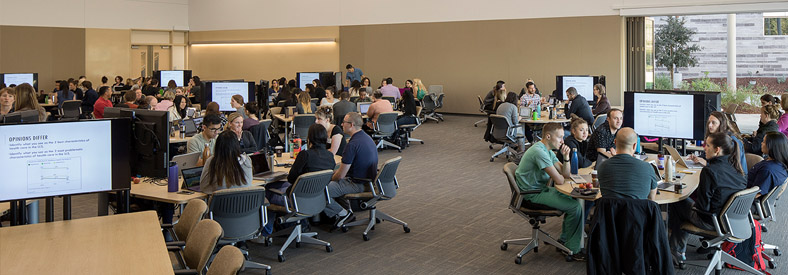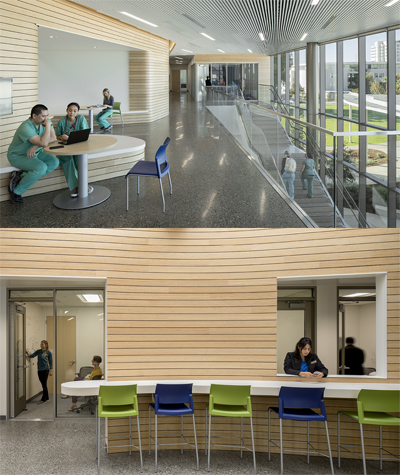Learning Spaces Foster Collaboration and Inspire Innovation

Confucius said, “I hear and I forget. I see and I remember. I do and I understand.” Clearly, the idea of active learning dates back ages, but new research validates that student-driven education promotes retention far better than lecturing. Educators must embrace this new generation of learners today to create effective health care leaders for the future. Betty Irene Moore School of Nursing at UC Davis faculty recognize the days of passive note-taking are over. Subsequently, learning spaces must engage students.

Learning commons in the new Betty Irene Moore Hall support active learning in step with a philosophy of collaboration.
“Adults learn best when they are actively participating and pursuing lines of inquiry that they generate themselves,” says Debra Bakerjian, clinical professor. “We are moving from faculty being a ‘sage on the stage’ to an environment where educators are the ‘guide on the side.’” Design that moves instruction from a single cell to multiple points of interaction permeates Betty Irene Moore Hall. To prepare future health care leaders, nurse faculty and researchers, the School of Nursing must equip health care professionals with skills to make life-or-death decisions quickly. Interactive learning enables graduates to quickly recall retained information in stressful situations.
Exciting designs within Betty Irene Moore Hall consist of learning commons and active-learning spaces that are an extension of innovation and adaptability.
“This building supports a philosophy and our commitment to create an environment of collaboration,” adds Theresa Harvath, executive associate dean. “Our faculty must be more nimble than ever to create a network of courses that resembles a spider web with connectivity across the curriculum.”
Students, faculty and the community are surrounded by open spaces that vary in size, depending on location, ranging from larger meeting spaces to smaller niches to foster collaboration. The three active-learning classrooms housed in Betty Irene Moore Hall, 175-, 125- and 60-seat rooms, adapt to emphasize group learning and creative use of multimedia tools.
“Actively engaged students are more likely to recall what they learned later within a variety of situations and contexts, thus increasing their ability to improve care. That’s ultimately why we are here,” Harvath adds. “These active-learning spaces also serve as a resource for our colleagues in the schools of medicine and public health. Learning, collaboration and interprofessional interaction will never cease within these walls.”





